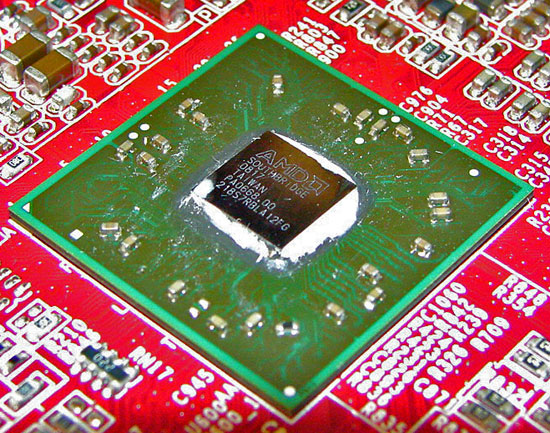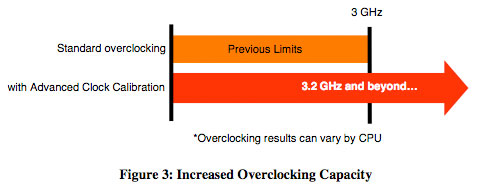AMD's SB750: Enabling Higher Phenom Overclocks?
by Gary Key on July 23, 2008 12:00 AM EST- Posted in
- CPUs
The new SB750, or more like a SB700 with BOTOX-

The SB750: I remember when South Bridges weren't built on flip-chip packages
While technically a new part, the SB750 appears to us to be a point upgrade to the SB700. However, it is a major improvement over the SB600 used on the current 790FX boards. Anyway, let’s get into what has changed and what has not.
The SB700/750 features six SATA 3.0Gb/s ports, up from four on the SB600, with the ability to reserve up to two of those ports for eSATA connectivity. Drives can be set up in RAID 0, 1, or 10 and RAID 5 now makes its appearance in the SB750. We just received a beta set of drivers for this new feature, but at first glance, it appears to work fine at this point.
Still missing in action is a native interface for networking support. AMD continues to use an external PHY and MAC for network operations. Although performance is similar to the NVIDIA and Intel solutions, this setup does incur a cost penalty for the motherboard suppliers.
The major improvement in the SB700/750 series over the SB600 is the increase in USB 2.0 performance and the number of ports available. The new dual-channel controller features 12 USB 2.0 capable ports and 2 specific 1.1 ports for compatibility reasons. USB 2.0 performance is now on par with the Intel and NVIDIA solutions.
A single PATA channel provides native IDE support for up to two drives. This channel supports PIO, multi-word DMA, and Ultra DMA 33/66/100/133. Six PCI lanes are still included although we doubt a board manufacturer is going to offer that many. AMD dropped HyperFlash support on the SB700 to make way for the new Advanced Clock Calibration interface.
The SB700/SB750 features four PCI Express lanes for the A-Link Express II interconnect, but like the current 790FX/780G series or upcoming product that we dare not mention, those four lanes are based on PCI Express 1.1 specifications. That means the interconnect bandwidth is capped at 2GB/s, half of what it would be in a PCI Express 2.0 configuration.
Finally, we have the High Definition Audio controller carried over from the SB700 that allows up to 16 channels of audio output per stream. The controller supports up to four codecs with sample rates reaching 192kHz at up to 32-bits per sample.
How it Works, um, Kinda
AMD was extremely vague in explaining to us exactly how the new SB750 South Bridge actually improved Phenom overclocking. At first all we were given was these two diagrams:

Clearly.

It makes it faster.
You see, the SB750...yeah, these pictures really meant nothing to us so we dug a little deeper with AMD.
Here's what we do know:
The SB750 now has a direct 6-pin interface to the AM2+ socket on the motherboard, there are now pins on the Phenom CPU that connect directly to the SB750. These pins were previously unused and are now used as a means of communication between the South Bridge and the CPU. The SB750, in combination with an updated BIOS, can now override some of the CPU's internal settings which can potentially increase the overclocking headroom of the chip.
AMD says that the settings tweak doesn't impact performance and doesn't change thermals or voltages, it simply can allow a Phenom processor to clock higher when overclocking. The BIOS exposes the parameter being changed, which AMD refers to as the Advanced Clock Calibration (ACC) value. Typically this value has a range of -2 to 0, on motherboards with the SB750 that support ACC the value can be set from -12 to +12. Higher numbers should allow for higher clock speeds, while lower values should allow for lower voltages/lower power operation.
Even after further pressuring, AMD wouldn't tell us what this value actually adjusts - simply stating that it makes it easier for the CPU to run at higher speeds. Based on AMD's careful choice of words, it would seem that adjusting the ACC somehow changes the acceptable margins of operation for the CPU cores (the value can be changed on a per-core basis in AOD or BIOS). By loosening these margins, however it is able to do so, the SB750 + ACC combo can enable many Phenom processors to operate outside of their normal overclocking margins. In fact, AMD is confident enough about the technology that they are willing to state that on average; a 100MHz to 300MHz increase in clock speeds is attainable by the user after some tweaking.
The SB750/ACC trick doesn't work on anything other than Phenom processors, and it works particularly well on the Black Edition processors. While AMD didn't rule out eventually enabling this on K8 based cores, it is a Phenom-only option for now. Reaching higher clock speeds is more of a top priority for Phenom, and it's unclear whether or not whatever AMD is doing here can even work on K8 if they tried. AMD also committed to enabling similar tweaks for upcoming 45nm based Phenom parts, implying that this was not a short-term solution to the clock speed problem.
At the same time, AMD implied that the tweaks that the SB750/ACC feature enables could be incorporated into the manufacturing chain and actually implemented in hardware. There's something strange going on here, but as you'll soon see - the tweak actually works.
Microprocessors are designed to operate in even the most extreme of conditions, AMD seemed to imply that its ability to adjust the ACC value somehow changes this. Curiously enough, AMD cited "competitive concerns" as a reason why it would not disclose exactly what's going on with this new overclocking feature. We can't help but wonder if it is because AMD is going a little too far in the sacrifices it's willing to make in the quest for higher clock speeds.










48 Comments
View All Comments
wingless - Wednesday, July 23, 2008 - link
"In the end, we know after a good 60 hours of testing, over 600 different settings, 400+ screen shots, and countless reboots that Advanced Clock Calibration works, yet we do not know anymore about ACC at this point from AMD than SpongeBob SquarePants."AMD does nothing but right their wrongs these days. The SB750 is gonna be big for them. I'm amazed that Anandtech went through so many combinations trying to bring this thing down. They have proven without a doubt that this technology works.
I also can't wait until next week. They have given us confirmation that 790GX and 790FX boards with SB750 will be coming out NEXT WEEK! Also they keep mentioning some part that they "dare not mention". WTF is that going to be? I thought 790GX+SB750 was going to be the big news. Theres something else? Next week will be exciting for AMD in all the GOOD ways.
ZootyGray - Thursday, July 24, 2008 - link
Yup - I come here to hear about the results of what I call "brutal testing" rather than read somebody's hype or bias or sloppy inconclusive testing. I am still fairly new here but I believe Anandtech is the real thing.I want that to be true, esp. after wasting my time at tom's bubblegum guide with there trash bias garbage misleading bullschtein socalled reviews.
These guys are working hard to get the real goods - and in contact with AMD, delaying reports promised 'tomorrow' - who cares - they are willing to go to amazing lengths to output accurate info after deeper investigation.
This is no kiddy's website - it's a hard read to get through it; and I know I am not the only one who will reread it to better comprehend what I missed the first time through. This testing is consistent with the articles on 'the 3 amigos' and the one about the recent additions to the AMD line, including the 9950. Take it apart, what makes it squeal.
Also, it seems there is something different about the 9950, and it's not just an oclok 9850.
Looking forward to more next week - and the ?? mystery ?? item????
Big change on the AMD scene - wow.
Calin - Thursday, July 24, 2008 - link
I've quit reading Tom's Hardware long time ago - when I think it was a good site. However, Anandtech was better overall, and one site was enough :)As for in depth reviews... this should qualify as an easy reading, look for the technology behind NVidia's 280 and 260 series GPU for a "transistor-oriented" article - that's a hard read indeed
Comdrpopnfresh - Wednesday, July 23, 2008 - link
I am really interested to see how an ASUS or DFI board with the new sb do in overclocking and performance. As mentioned this board is more of a feature-rich pick. And just looking at the charts of ACC off on the foxconn vs the ASUS with sb600, I hope there will be more of an improvement with a fresh sb750 variant.Interesting though about the pci-e 1.1 and lan choices by amd. Is it possible having those two remedied would hinder the improvement by ACC?
Really looking forward to new comparisons to Intel chips with the new change. Hopefully with 45nm parts and ACC, amd can have a good go.
One thing I would like to know though: What are the specs on the sb750 foxconn vs the asus sb600 in terms of the number of phases in power delivery?
Goty - Wednesday, July 23, 2008 - link
I think that there must be some underlying issue with either the chipset drivers or windows itself when it comes to differing final overclocks, as the CPU shouldn't necessarily be aware of what kind of software its running, other than the fact that a few more registers are being used. IS there any evidence that this is a Phenom-specific issue, or might it affect Athlon64's as well?Locutus465 - Thursday, July 24, 2008 - link
Quite honestly, either way I would run 64bit over 32bit any day of the week period... I'm sorry but the little bit of extra performance you get OCing really doesn't out weigh the many many advantages 64b vista has over the 32b variant (and over XP). Simply put, 32bit operating systems are all but done in my home... I do run 32bit vista on my laptop but only for the following reasons:HP put 32bit on here, and it seems to me all their custom drivers and software (which seem to be required to keep the system from crashing) are all 32bit... so oh well.
This is a budget laptop to begin with and it maxes out at 2GB RAM... The extra overhead of 64b would just be more of a performance killer than anything else.
No gaming will be done on this laptop (so no need to worry about future games needing more that 2GB for a process) and I have my desktop at home if I need to manipulate large flat files.
Now my desktop? Yeah...
Phenom 9850BE
4GB OCz DDR2
Radeon 3870...
It's getting the 64bit treatment all the way :)
CyberHawk - Wednesday, July 23, 2008 - link
... boy, I was waiting for this one :DFireTech - Wednesday, July 23, 2008 - link
So was I ;)It leaves me with more questions than answers though. Time to re-read and await further developements/articles.